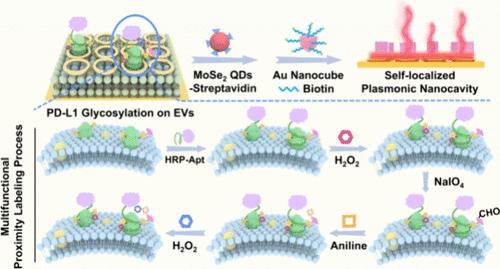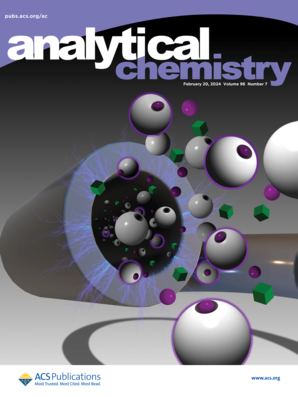Self-Localized Plasmonic Nanocavity Strategy for the Glycosylation Detection of Glioblastoma Extracellular Vesicles
IF 6.7
1区 化学
Q1 CHEMISTRY, ANALYTICAL
引用次数: 0
Abstract
The protein glycosylation of extracellular vesicles (EVs) is involved in cellular recognition and emerges as a promising biomarker for cancer diagnosis. However, the lack of efficient labeling and high-resolution detection strategies limits their clinical application. Herein, we developed a self-localized plasmonic nanocavity strategy to analyze the glycosylation characteristics of glioblastoma EVs. First, an engineered phospholipid bilayer structure with a Au nanoring array was designed to capture EVs and induce membrane fusion. Relying on the multifunctional proximity labeling process, a peroxidase-induced proximity labeling was designed to label sialic acid on programmed cell death ligand 1 (PD-L1) of EVs. Based on the identification and labeling process of EVs, the plasmonic nanocavity was self-localized with Au nanocubes and achieved the spontaneous location of MoSe2 QDs. The uniformly enhanced electromagnetic field in the nanocavity resulted in the polarized luminescence signal of MoSe2 QDs for improving the detection sensitivity and resolution. This system demonstrated the precise distinction and sensitive quantification of EV glycosylation in cerebrospinal fluid to distinguish glioblastoma. This research provided a novel strategy for the glycosylation detection of EVs and promoted the clinical application of EVs in glioblastoma diagnosis.

求助全文
约1分钟内获得全文
求助全文
来源期刊

Analytical Chemistry
化学-分析化学
CiteScore
12.10
自引率
12.20%
发文量
1949
审稿时长
1.4 months
期刊介绍:
Analytical Chemistry, a peer-reviewed research journal, focuses on disseminating new and original knowledge across all branches of analytical chemistry. Fundamental articles may explore general principles of chemical measurement science and need not directly address existing or potential analytical methodology. They can be entirely theoretical or report experimental results. Contributions may cover various phases of analytical operations, including sampling, bioanalysis, electrochemistry, mass spectrometry, microscale and nanoscale systems, environmental analysis, separations, spectroscopy, chemical reactions and selectivity, instrumentation, imaging, surface analysis, and data processing. Papers discussing known analytical methods should present a significant, original application of the method, a notable improvement, or results on an important analyte.
 求助内容:
求助内容: 应助结果提醒方式:
应助结果提醒方式:


